Historic floods strike Wheeling twice in as many weeks; Will state lawmakers invest in resiliency programs?
Wheeling experiences historic flooding as record-breaking rains fall across the region. Lawmakers refused to fund a resiliency trust fund this year. Will they change their minds?
Wheeling, W.Va. – Flood waters have invaded low lying neighborhoods across the city for the second time in as many weeks. Residents of Wheeling Island were again faced with the potential for flooded basements as the area experienced its worst flooding in nearly twenty years.
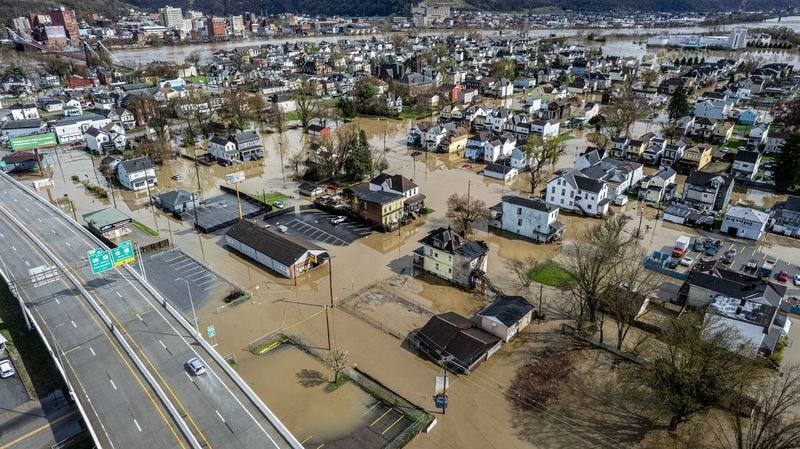
On April 5 the Ohio river crested in Wheeling at 41.49 feet–just inches from ‘major’ flood stage. The last time the city was subjected to this type of flooding was January 11, 2005, when the river rose to 42.2 feet. For many younger residents this was the first time seeing their neighborhood streets submerged.
The April 5 flood is attributed to torrential rains across the region. A month’s worth of rain fell on an already saturated ground from late-March rainfall. Wheeling saw four inches of rain in two days with similar totals measured across the region. For reference, Wheeling typically sees 3.38 inches of rain for the month of April.
The storm that caused the flooding on April 5 also spawned at least ten tornadoes in southern West Virginia, a state that typically sees just two tornadoes per year.
Flood waters caused at least two deaths in the Upper Ohio Valley, including a man in Guernsey County, Ohio, and a woman in Wood County, West Virginia. Governor Jim Justice declared a state of emergency for the Northern Panhandle prior to the April 5 flood.
Other communities in the area, including Wellsburg, W.Va, Moundsville, W. Va, Powhatan Point, Ohio, and Marietta, Ohio, were also devastated by the floods
As the river crested on Thursday evening, residents on Wheeling Island and in the neighborhoods of Downtown, Center, and South Wheeling saw feet of water flood their basements and streets. Those who heeded warnings were able to disconnect and relocate their water heaters and furnaces, move their vehicles, and stock up on supplies.
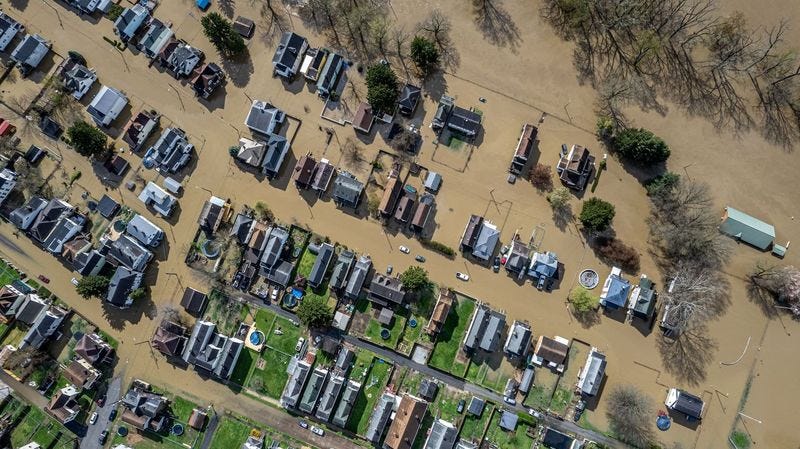
Robin Davis and her 12-year-old son, Abraham, residents of North Wabash Street on Wheeling Island, met with this reporter on April 4 as Wheeling Free Press was on site documenting the flood. They said they witnessed water evacuations occur down the street from their home.
“It’s scary, I guess you could say. People are stuck on their porches. Others are just waiting it out. People are leaving … it’s a mixed conversation,” Abraham said.
Robin said she was considering evacuating with her kids, depending on if their home lost power. Thankfully, it didn’t. She spoke about how the house was without heat after unplugging and relocating their furnace. Temperatures Thursday dropped into the low-40s.
This isn’t Robin’s first flood–she grew up on the island–but it is a first for her son. “Honestly, it does scare [me] a little bit,” Abraham said as he described watching the water slowly rise and eventually reach their home.
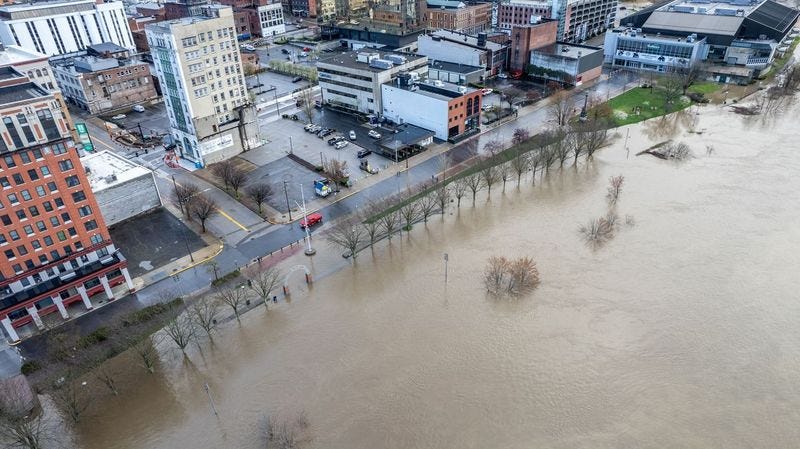
Water at Heritage Port rose to the rail trail just feet from flooding the street. Many in the community came to bear witness and photograph despite the Wheeling Police Department closing the area. Senator Joe Manchin, joined by Wheeling mayor and U.S. Senate candidate Glenn Elliott, also came on Thursday to reassure residents.
Several businesses were impacted by the flood waters, too, including Waterfront Hall on Water Street. Waterfront Hall opened in August 2023 and is one of the largest private investments in Wheeling’s downtown in recent years. The building is home to a bar operated by Waterfront Hall and two restaurants that lease out space–Wood Fired Pizza and Avenue Eats.
This reporter spoke with the owner, Dan Mileson, as he and his staff were beginning to pump two feet of water from their basement. When asked if he was concerned about the flooding Mileson said the building, erected in 1877, has been “undergoing floods for 150 years–and it’s still standing.” He estimated damages could total between $3500 to $5500.

The popular bar and eatery was forced to close Thursday, but quickly reopened by the afternoon of the next day.
Rising waters weren’t the only risk of the storm. In several communities hillsides gave way, spawning mudslides that shut down a major thoroughfare, endangering homes, and burying hundreds of graves at a historic cemetery.
West Virginia Route 2, or River Road, was shut down for two days after a landslide covered the street with earth, trees, and debris. The state-owned road connects the northern Wheeling neighborhood of Warwood to the city proper and serves as a major transit corridor in the area.
City and state employees originally predicted the closure to last for a week, but were able to reopen River Road in two days–a welcome expedited remediation as detours saw travel times from Warwood to downtown double.
Another landslide in Warwood came within feet of a family home. On Park View Road, leading to the county’s high school, a home collapsed after a landslide caused its foundation to buckle and ultimately give way.
Just outside Wheeling’s city limits along Fairmont Road, linking Center Wheeling with the Mozart neighborhood, a massive landslide buried several hundred graves at the Mount Zion cemetery. It is believed that no caskets or coffins were unearthed by the hill slip.

Mt. Zion cemetery opened in November 1863 when it hosted its first burial, a child named Annie Hofmeister. Over 1,000 people are estimated to have been buried at the cemetery with space for 200 more plots.
The cemetery had sat in disrepair for decades until 2015 when a group of volunteers began caring for the site. State officials, including Delegate Shawn Fluharty and Senator Ryan Weld, have pledged to aid in recovery efforts.
Waters began to recede on Saturday, April 6, allowing residents to pump their basements and clean out the trash left in its wake. Volunteer groups, joined by local and statewide candidates, assisted in cleanup efforts throughout the week.
Ebhann Campbell and Shea Mohring, residents of North Erie Street on Wheeling Island, told this reporter about the cleanup efforts a week after over four feet of water flooded their basement.
This was the first flood Mohring has experienced. “It sucked,” Mohring said.
Commenting on the rising waters, Mohring had a moment of panic. “Not only was I worried about ourselves, but other people and their animals too. How am I supposed to believe [the water] is going down when I keep seeing it get higher.”
Campbell was on the island during the 2004 and 2005 floods, so he had an idea of what to expect. “My first thought was to raise things…move the furnace and the water heater,” he said. “We realized that wasn’t going to cut it,” ultimately moving the utilities to the first floor.
Cleanup entailed rinsing the mud off the walls of their basement and spraying everything down with bleach. Campbell and Mohring said they were lucky, though. They had help from neighbors and friends. They were concerned, however, about a lack of “state-sanctioned help” on the island.
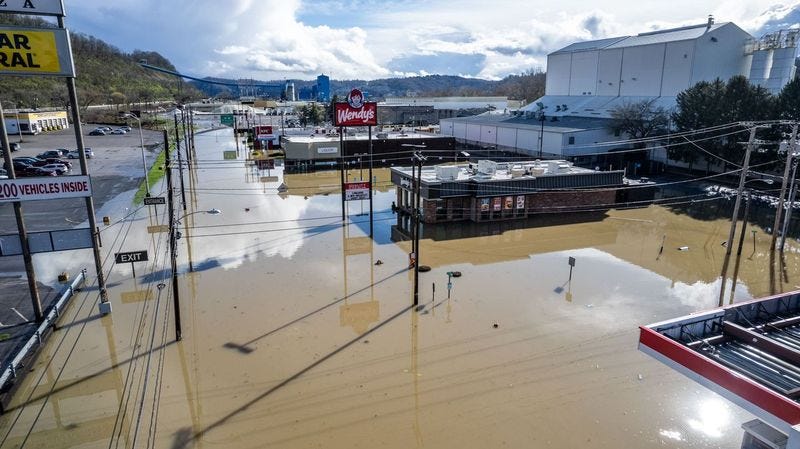
Just a week after the initial flood had crested and subsided, Wheeling faced another period of torrential rain beginning on April 11. Over the course of two days the city saw another 1.5 inches of rainfall, with the region seeing similar totals. Pittsburgh, PA, saw 2.77 inches of rain in a single day.
The Ohio river again reached flood stage in Wheeling by the evening of April 12, with the crest topping out at 37.8 feet on April 13. Some residents on Wheeling Island who had just finished clearing their basements were again faced with minor flooding.
This round of flooding also caused twenty-six barges to break loose in Pittsburgh, PA, striking a marina, dam, and at least one bridge. Another barge in Parkersburg, W.Va, struck a train bridge in the city.
The flood on April 5 is now, preliminarily, the 26th worst flood Wheeling has faced with records dating back to the mid 1800s. The April 13 flood will likely become the 36th worst flood.
As the climate warms scientists say the atmosphere is able to hold more rainfall leading to an increase in flooding potential. Data from Climate Science Special Report shows our planet has warmed 1.9 degrees Fahrenheit since the industrial revolution, and the United States has become four percent wetter.
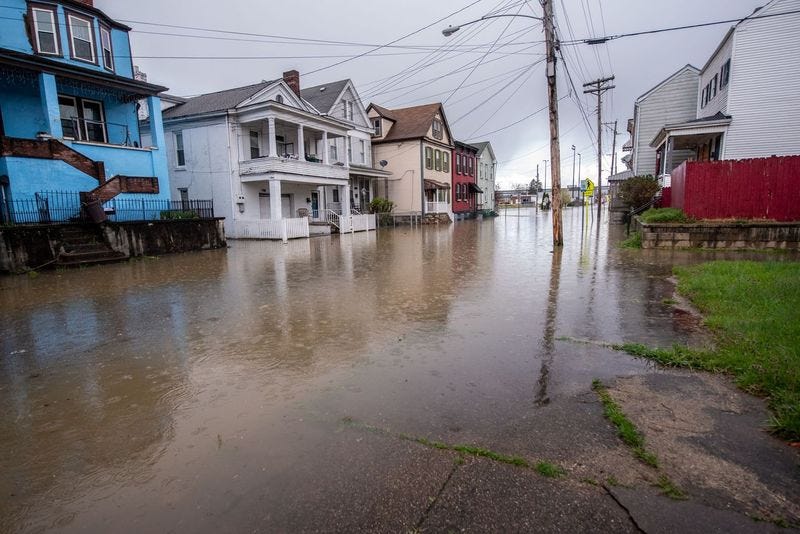
West Virginia is considered one of the most flood-susceptible states in the nation. From January 2007 to March 2022 there were 1,683 recorded floods across the state, totalling $54 million in damages and 34 lives lost.
State lawmakers unanimously approved a bill in 2023 that created the West Virginia Flood Resiliency Trust Fund, and directed the state to create a comprehensive flood resiliency plan. The West Virginia Legislature declined to allocate $50 million to the Trust Fund, despite Governor Justice requesting the same.
The governor said in a press release on April 11 that he would add the issue to an ‘upcoming special session’ relating to the budget. No date for a special session was discussed, but the governor has stated it would happen prior to the May 14 primary election. Lawmakers are in Charleston this week for April interim meetings.

